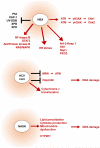DNA damage response and sphingolipid signaling in liver diseases
- PMID: 26514817
- PMCID: PMC5053096
- DOI: 10.1007/s00595-015-1270-8
DNA damage response and sphingolipid signaling in liver diseases
Abstract
Patients with unresectable hepatocellular carcinoma (HCC) cannot generally be cured by systemic chemotherapy or radiotherapy due to their poor response to conventional therapeutic agents. The development of novel and efficient targeted therapies to increase their treatment options depends on the elucidation of the molecular mechanisms that underlie the pathogenesis of HCC. The DNA damage response (DDR) is a network of cell-signaling events that are triggered by DNA damage. Its dysregulation is thought to be one of the key mechanisms underlying the generation of HCC. Sphingosine-1-phosphate (S1P), a lipid mediator, has emerged as an important signaling molecule that has been found to be involved in many cellular functions. In the liver, the alteration of S1P signaling potentially affects the DDR pathways. In this review, we explore the role of the DDR in hepatocarcinogenesis of various etiologies, including hepatitis B and C infection and non-alcoholic steatohepatitis. Furthermore, we discuss the metabolism and functions of S1P that may affect the hepatic DDR. The elucidation of the pathogenic role of S1P may create new avenues of research into therapeutic strategies for patients with HCC.
Keywords: DNA damage response; Hepatocellular carcinoma; Lipid mediator; Sphingosine-1-phosphate.
Figures


References
-
- Fujimaki S, Matsuda Y, Wakai T, Sanpei A, Kubota M, Takamura M, et al. Blockade of ataxia telangiectasia mutated sensitizes hepatoma cell lines to sorafenib by interfering with Akt signaling. Cancer Lett. 2012;319:98–108. - PubMed
-
- Arii S, Yamaoka Y, Futagawa S, Inoue K, Kobayashi K, Kojiro M, et al. Results of surgical and nonsurgical treatment for small-sized hepatocellular carcinomas: a retrospective and nationwide survey in Japan. The Liver Cancer Study Group of Japan. Hepatology. 2000;32:1224–9. - PubMed
Publication types
MeSH terms
Substances
Grants and funding
LinkOut - more resources
Full Text Sources
Other Literature Sources
Medical

